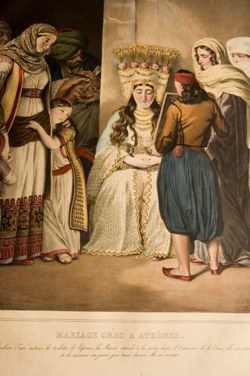Travelers Project

Project Coordinator: Aliki Asvesta
The Gennadius Library has a rich, rare collection of travelers’ books. Its founder, Joannes Gennadius, a passionate and knowledgeable collector, assembled a library that enlightens many aspects of Greek history and culture; he placed special importance and weight on the travelers’ literature especially on their observation of alterity and particularly of the activities, habits, doctrines, laws and ties between the Greeks and other ethnic (national) groups that lived in the regions of the Ottoman Empire.
Through the eyes of the Other, European artists, collectors, antiquarians and diplomats, merchants, naturalists and clergy wrote down in their travelogue their quest and the ways in which they realized and accomplished the objectives of their missions and wanderings in the regions of Ottoman Empire; they recorded their experience and observations, but also the thoughts, which were generated when they looked at and came into contact with another world.
The experience borne from bridging a distance, often away from the native land, with intermediary stops and transitions to other destinations, the conquest of something different and the escape from what is known compose the traveling text in the form of letters to familiar persons, reports to collaborators and personal diaries. At a period when traveling was dangerous, the traveling text functioned in a multiplicity of ways. The traveler/ author was interested in transmitting and keeping memories and images of a distant world that was difficult to see again; the readers / recipients shared the traveling experience through their imagination, since for them traveling during that time was a practically unattainable enterprise or simply a dream.
Objectives
The Travelers’ Project at the Gennadius Library aspires to facilitate the research and recovery of information contained in travelers texts located in the Library. The project begun before the advent of personal computers but some years ago it was converted into an electronic database in Access format. The database will soon be accessible via the internet.
We hope that this project will constitute the basis for a complete inventory of the rich information that we find in the travelers texts on Greece and will soon be linked with similar undertakings as well as images and digitized texts from other Greek or foreign libraries so as to constitute a dynamic source of knowledge on this material. There already exists cooperation with other academic institutions on this material, most notably with the National Hellenic Research Foundation.
Description
The majority of the Gennadius travelers’ texts come from rare and old books collected by the founder of the Library at the end of 19th and the beginning of the 20th century in London. It is well known that during the Ottoman period Greece exerted a particular attraction on travelers. Travelers accounts constitute an important source of information –albeit one-sided—for Greece, especially in what concerns its natural and historical landscape. Based on imaginary or real travels, these texts date from 1500 to 1840 and cover the period of Ottoman or Venetian rule as well as the newly established Greek state. The nature of the texts themselves varies from simple, short references to specific places to rich descriptions of antiquarian achievements followed by rare illustrations of monuments and important archaeological sites. Nonetheless, these texts offer rich material for the historians, the archaeologists or the naturalists.
Geographical distribution
The project gives emphasis to the area of the Balkans, Asia Minor, as well as the regions under Venetian or Frankish rule. The historical information contained in the travelers texts – as it emanates from the personal point of view of each traveler—is classified into thematic units focusing on: the natural and built environment, antiquities, social and economic life, everyday life and culture, and politics. In a schematic way these categories constitute what we often call «global history».
Principles of cataloguing
Every traveling text is catalogued and described bibliographically according to:
a) Traveler’s or author’s name
b) Book title
c) Call number at the Gennadius Library
d) Chronology of travel or the broader historical period during which the travel was accomplished
e) The place or the broader geographical region, which the traveler describes
The historic information contained in each text is selected and presented in thirteen thematic categories. These thematic units stem from extensive research on the very subjects that are treated in the texts themselves according to each distinct time period but also from actual, typical queries of Gennadius Library users.
1) Antiquities
2) Architecture
3) Natural history
4) Health
5) Population and ethnic groups
6) Financial and economic life
7) Crafts
8) Production and pre-industrial techniques
9) Cultural life
10) Mentalities and everyday life
11) Religious doctrines and life
12) Political structures
13) Travel conditions
Every unit is divided into subunits, which give a more detailed description of a topic according to the evidence given by each traveler. In his search the user can generalize or define the geographic expanse and the historical period of the thematic unit. There is the option of simple or advanced search that produces references to specific pages; no full text of the citation is available.